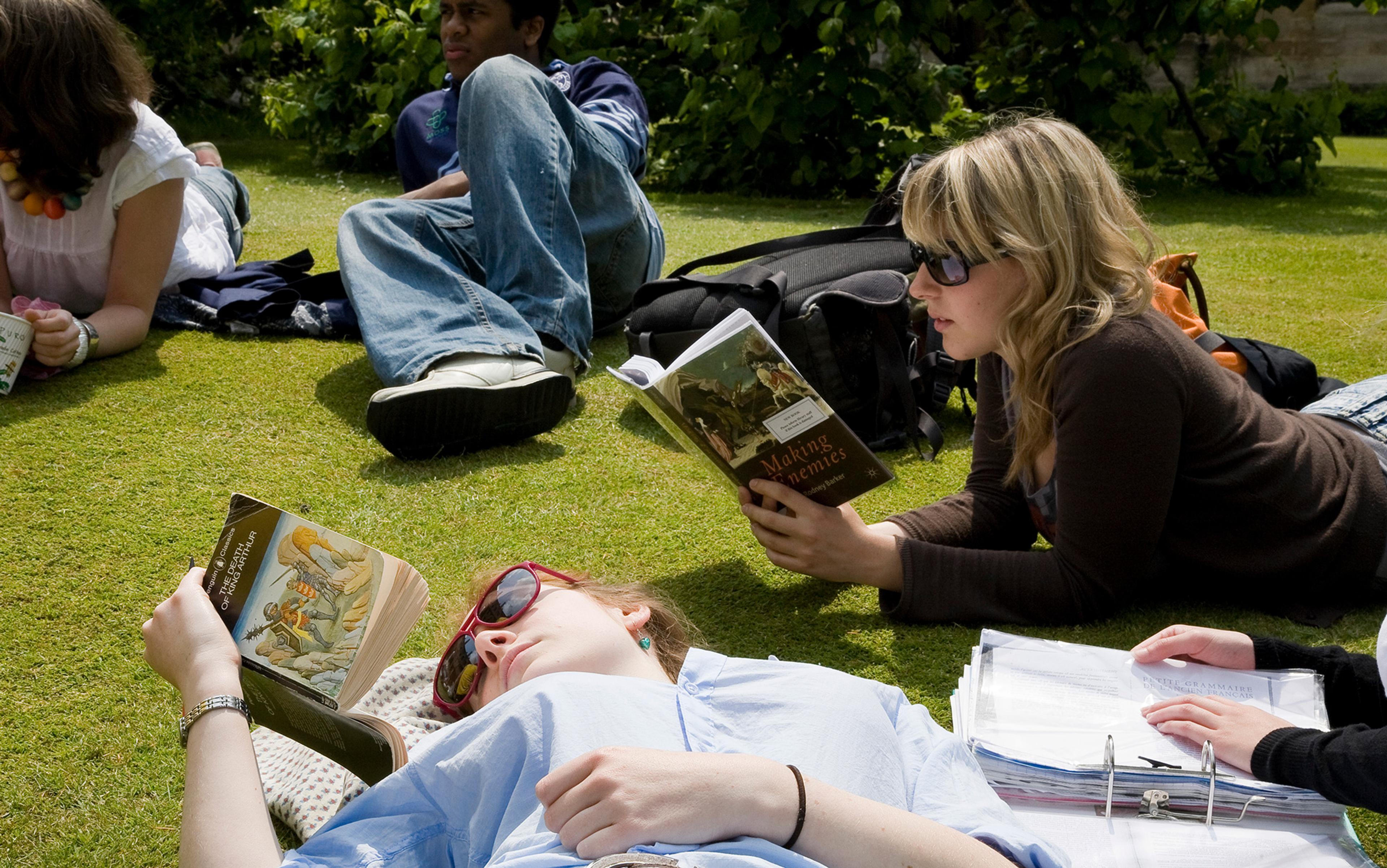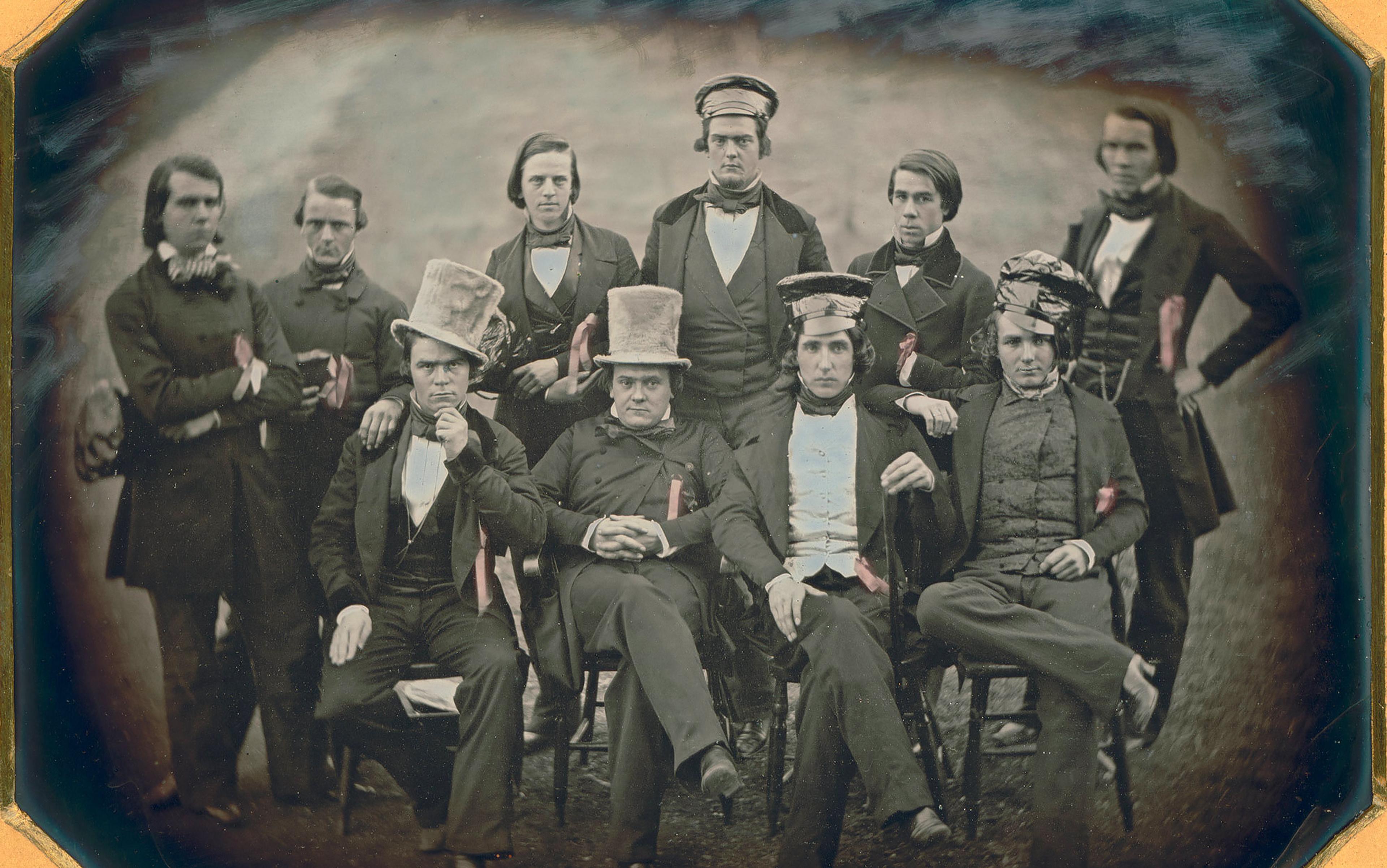The humanities are in crisis. It’s become orthodoxy. In fact, so much attention has been paid to the ‘crisis of the humanities’ that few have stopped to ask if there actually is such a crisis. Over just the past few generations, enormous changes have transformed higher education. These changes have brought a greater proportion of 18-year-olds to university. In the case of most countries apart from the United States, this brings a huge increase, from a low base – and thus tremendous changes in the composition of that student body in terms of class, gender, ethnicity and other key markers. In each generation, commentators have predicted (and policymakers have demanded) that the humanities would suffer from a more utilitarian, career-oriented, tech-savvy influx. But it hasn’t happened.
In the English-speaking world, over the past half-century, the proportion of students studying humanities at university has hardly changed. True, as one might expect, in the US, the United Kingdom and Australia, there have been fluctuations and important changes in educational demographics, most importantly more women going to college. The crude picture is this: in 1971, humanities students outnumbered business students; now it’s the other way around. But in 1971 there were also about 50 per cent more business majors than science majors; now there are about 250 per cent more.
So relative to business, both the sciences and the humanities have fallen behind since 1971, and the sciences much further. Since the 1980s, however, the gap between the humanities and business has, in fact, shrunk, while the gap between the sciences and business continued to grow. And, very importantly, the rapid expansion of higher education in the world over the past couple of generations means that, in absolute numbers, more people are studying the humanities than ever before.
The question is why humanists have not been able or willing to recognise their own sustained success.
First, understanding the performance of almost any aspect of higher education today requires recognising its continuous and sometimes explosive growth over the past half century. The US made the earliest transition to mass higher education, which makes the UK and Australia two productive comparators, offering a diversity of experiences within the Anglophone world.
There are some differences, of course. The US is a late specialisation system, where students don’t choose a subject until their third year in higher education. The UK is an early specialisation system, where students choose a subject while still in school. Australia lies somewhere in between. The US is a large, sprawling, highly variegated system, with no central control over student numbers, curriculum or tuition fees. The UK and Australia have more compact systems, they are more homogeneous and, in theory, their governments have considerable central control over higher education.
The US made the transition to mass higher education first, reaching levels of participation in the 1960s that other advanced nations did not achieve until the 1990s. The US reached gender parity in undergraduate enrolment by 1965, whereas it was 1987 for Australia and not until after 1990 for the UK. More broadly, the UK is reputed to have a wider culture which is friendly to the humanities; the US and Australia do not.
Underneath these differences, all three countries have experienced common patterns of recruitment to undergraduate degrees. Both the sciences and the humanities have declined in relative share, but not catastrophically. There is no period to which one can point and say ‘There is the crisis of the humanities!’ To the contrary, the absolute numbers of humanities graduates have grown and grown. In contrast to the sciences, the relative share of the humanities has held up quite well. Why? What determines changing subject choice anyway?
Many people idealise the 1950s as the golden age of higher education – the decade of five-cent Cokes, Burma Shave signs and hard-working white people (as the Doonesbury comic strip had it), and also of mass deference to European high culture, of pony-tailed co-eds walking to class with their books (Plutarch, Shakespeare, Nietzsche) carried by lanky, letter-jacketed philosophy majors. In this so-called golden age, across the countries of the Organisation for Economic Co-operation and Development (OECD) in 1955, the humanities accounted for about 20 per cent of all students – hardly riding high.
In the exclusive system then prevailing in most European countries, medicine, law, engineering and technology all did well because they led to highly credentialised professional occupations for men. In contrast, the humanities, while attractive to a tiny minority as a general education for gentlemen, led for most (especially women) directly only to employment in schoolteaching. In the more mass-oriented US system, the humanities in the 1950s already competed with a range of more vocational majors, for example business. Only about 11 per cent of US students in the 1950s majored in the humanities.
Australia in the 1950s, then a very elite higher-education system, looked more ‘traditional’. The country’s politicians seem to have had more respect for the humanities then. Teaching costs and thus fees were lower for what Australians and Britons alike called ‘arts’ degrees, although the ‘arts’ referred to almost anything that wasn’t a science. The arts’ market share rose steadily throughout the 1950s – from 19 per cent to 31 per cent. If there was a golden age for the humanities anywhere, it might have been Australia in the 1950s.
Toward the end of the 1950s, the humanities’ relatively modest achievements were threatened in all three countries by an effort among politicians to redirect national energies to science. In the US, the Cold War was a factor, especially after the launch of Sputnik in 1957. In the UK, fears of relative decline added weight. Australia was driven to try to join the top table of developed economies. All three countries went big for the ‘growthism’ that swept across the world in the late 1950s and early ’60s. It was an extraordinary moment of optimism in the power of science and technology. It also marked the first great ‘crisis of the humanities’ in educated discourse.
It proved far easier to attract new entrants to humanities, and to new subjects in the social sciences, than to science and technology
In his celebrated book Crisis in the Humanities (1964), the British historian J H Plumb maintained that the gentlemanly arts must ‘change the image that they present, adapt themselves to the needs of a society dominated by science and technology, or retreat into social triviality’. In the same year, a gloomy report on the future of the humanities in Australian universities described professional humanists as ‘on the defensive in a world unfavourable to their values’. The governments of the US, the UK and Australia all committed to increased investments in science and technology higher education with the longer goal of economic growth.
But Plumb was wrong. Even as governments pushed science and technology for growth, undergraduates at Australian and UK universities moved away from science. By 1968, this move was recognised across the OECD. With politics and policy pushing science, why did the opposite happen? Quite simply, it proved far easier to attract new entrants to humanities, and to new subjects in the social sciences, than to science and technology.
Law, medicine, and engineering – the traditional professions – stood somewhat apart. In contrast with business, science and the humanities, these professions did not wish to grow proportionately to the increasing student population. They maintained admissions quotas. They were relatively unfriendly to women and less-privileged groups. In contrast, the social sciences offered a bigger gateway to new jobs in the helping professions, in which both men and women were welcome. The humanities promised to satisfy a new yearning for self-expression, which over the course of the 1960s ripened into more political forms of liberation.
In the US, the humanities enjoyed an unprecedented boom, reaching their peak popularity of 17 per cent in 1968. Much of this golden age in the US can be attributed to the novel opening of higher education to women. The traditional professions – and by extension professionally-oriented subjects such as business – did not welcome women. But the humanities did, as the historian Ben Schmidt at Northeastern University in Boston argues.
The humanities were thought to be committing suicide by fighting ‘culture wars’, often in foreign languages
In the UK, the swing away from science benefitted social studies more than the humanities. The number of social-studies students overtook students of the humanities in 1972, and of sciences in 1976. The greater prevalence of social studies in Europe reflected the lag in women’s participation, and also the larger number of public-sector jobs in Europe: in the early 1970s, it employed more than half of all UK graduates, versus only just over a third in the US. Australians’ subject choices were more stable, because there were centrally determined quotas on subject numbers, a limited range of institutions, and fewer choices. Yet even here the swing away from science was evident.
At the height of growthism, policymakers had relied heavily on human capital theory, a new branch of economics, to justify their own (and students’) investment in higher education, rather narrowly interpreted as an investment in economic growth. The swing away from science forced them to broaden this interpretation, accepting that returns from higher education registered not only as direct investment in the economy but also as ‘social returns’ (improvements in individual and collective wellbeing not easily measured in monetary terms) and, most importantly, as a ‘consumption good’ – that is, ‘one of the decencies of life’ – or, as a couple of economists put it rather innocently: ‘people… want to go to university because they enjoy the education process, irrespective of the financial return to a degree’.
By the early 1970s, the significance of these non-economic returns to higher education was recognised across the OECD, highlighting the futility of ‘manpower planning’. As the OECD put it, students had their own ideas of what to study. This student demand was a natural expression of contemporary ideas of democratisation, widening participation, and the emerging value structure of the new student generation, comprising goals such as ‘self-fulfillment’, ‘quality of life’ and ‘individual development’.
This moment of enlightenment did not last long. The early 1970s were already witnessing a crisis for higher education generally. After the exuberant growth of the late 1960s, demand for higher education seemed to slacken suddenly, not only in the US and the UK, but also in Canada (though not in Australia). On the narrow human-capital definitions, higher education was an investment in decline, as the additional earnings graduates might expect over non-graduates began to drop, at least in the US and the UK, especially for science graduates. (Big cuts in government-sponsored space and military research programmes were largely to blame.)
Policymakers in the 1970s became wary of investments without direct GDP benefits. Self-fulfillment and individual development were all well and good, but the state didn’t have to pay for them. When the global economic crisis hit in 1974, the bottom fell out. Students didn’t want to pursue higher education. Policymakers didn’t want to invest in it. Voters didn’t want to pay for it. Students’ continuing shift away from the sciences hurt proponents of higher education, who had to make a case in investment terms.
In the 1980s, politicians moved to drive more students into the sciences, seen once again more narrowly as a catalyst to economic growth. In Australia, state funding of higher education as a share of GNP dropped by a third between 1975 and 1985. As state funding declined, state control over remaining funding tightened. The reforms led by Australia’s Labor Education Minister John Dawkins prioritised ‘those fields of study of greatest relevance to the national goals of industrial development and industrial restructuring’. In the UK, the Conservative government also revived human-capital arguments in order to boost science and engineering. Margaret Thatcher’s Education Minister Keith Joseph argued that much current higher-education output was economically valueless, even ‘damaging to the spirit of enterprise’. In the US, where government had fewer levers to control higher education, the advent of neo-liberal governments after 1980 was seen by many commentators to coincide with a new instrumentalism among the student population, which favoured vocational subjects over inspirational ones. The humanities, in particular, were thought to be committing suicide by fighting ‘culture wars’, often in foreign languages (French theory, poststructuralism, identity politics), which only widened the gap between them and the public.
In the 1980s, the cry of ‘the humanities in danger’ came from all quarters. Humanities enrolments in the US did decline in the 1970s and ’80s, but as Schmidt has shown, the nosedive was simply a gender effect. Women had reached parity in US higher education, yet professional careers were not open to them, so professional courses were less attractive. In the 1970s and ’80s, while remaining more faithful to the humanities than men, women began to populate courses such as business, journalism, communications and social work in larger numbers. By the 1980s, men were majoring in humanities at the same levels they were in the 1950s; meanwhile, women were much less likely to major in the humanities – and they went not to the sciences but rather to professional subjects. If anything, the sciences suffered more from the shift to professional courses, and from the shift to women.
Despite their professed devotion to democracy, humanists seem to have nursed a guilty feeling that mass higher education, however democratic, was not to their advantage
Something similar was happening in Australia and the UK, though for different reasons. Neither had experienced a sudden surge in the humanities in the 1960s, because neither country had opened higher education to significant numbers of women at the time. Instead, the UK and Australia in the 1970s and ’80s both experienced a mild decline in both sciences and the humanities. And in both cases professional courses benefitted. The swing away from the humanities and the sciences demonstrated some old lessons. Policymakers had had a very simpleminded understanding of the relationship between education, human capital and economic growth. Their efforts to steer students into the sciences were really a return to earlier, socialist ‘manpower planning’ in favour of certain industrial sectors. In both cases, students had their own ideas of what to study. In both cases, they didn’t respond to government incentives. They were following different signals.
The most important aspect of the neo-liberal reforms was the democratising effect of the unprecedented expansion of higher education. In the 1980s and ’90s, both Australia and the UK experienced a transition from elite to mass higher education that the US had made a generation earlier. State policies to encourage science studies were simply overwhelmed by enormous new tranches of students with their own choices to make. Both Australia and the UK had been preparing for this expansion since the 1960s, when they had developed a network of locally controlled technical colleges (called polytechnics in the UK after 1965), more connected to the world of work than to higher education. Inspired by the California Master Plan for Higher Education, developed by the economist Clark Kerr, President of the University of California, which had erected a ladder from the community colleges to Berkeley and other world-class universities, they intended these technical colleges to form part of a wider, more flexible higher-education system. In the great leap forward of the 1980s and ’90s, they were fully integrated into the university system, in Australia in 1988, and in the UK in 1992.
Despite their professed devotion to democracy, humanists seem to have nursed a guilty feeling that mass higher education, however democratic, was not to their advantage. This was partly because the sacrifices required by neoliberal reforms – more utilitarian criteria for students’ subject choices, bigger classes reducing the intimate scale of teaching favoured by the humanities – seemed to outweigh the benefits of expansion. But deep down there was also the lurking suspicion that a mass constituency just didn’t want or need the humanities, especially in the US.
Even though the US had made the transition to mass higher education a generation previously, it too was undergoing growth after a period of stagnation in the 1970s, and in conditions of considerable demographic change. Humanists were not optimistic about their chances in this environment. Vocationalism was thought to be rampant, and almost self-evidently inimical to the high‑minded aims of the humanities. A multi-ethnic population was likely to be hostile or indifferent to European high culture, on which the humanities still depended. Above all, though often only sotto voce, humanists worried that democracy was challenging their authority. And these fears persisted despite the mounting evidence that a mass higher education system was no more inimical to the humanities than an elite one.
The advent of mass higher education shifted the portfolio of courses toward the vocational. But ‘vocationalism’ only scratches the surface of what was happening. The new courses introduced through the technical colleges were not ‘technical’ in the sense of scientific or technological. Even ‘polytechnic’ didn’t refer to technology, as is often assumed – it means ‘many arts’.
The vast majority of entrants to non-university higher education in Australia and the UK before the merger of the two systems were not on science, technology, engineering and mathematics (STEM) courses. They were art students and education students and students taking courses in ‘social studies’, which included business, communications, social work and a whole slew of new subjects not then offered in traditional universities. Only a cluster of subjects allied to medicine – nursing, pharmacy, nutrition – gave the sciences a significant presence in these colleges. So, notably, the swing away from science registered as much, if not more, in the technical colleges (which were open to curricular innovation) as in universities (which were not). In the UK in 1988, just before the polytechnics were merged into the university system, 39 per cent of university students were taking STEM courses, compared with only 28 per cent of polytechnic students.
‘Social studies’ – by far the largest tranche of UK polytechnic students, larger than all science, technology and engineering students put together – includes business, accountancy and social work. It also includes communications, another group of students widely considered to be not vocational enough, embracing voguish new subjects such as gender, media and cultural studies. Mass higher education simply brought people with a wider range of motivations to higher education. Naturally, this influenced their subject choices – the labour market was a consideration, yes, but so was security, status, values, ‘the pursuit of knowledge and the desire for self-fulfilment’ as the OECD put it, a sense of vocation (that is, a ‘calling’, not necessarily vocational in the technical sense of the word). Above all, when higher education became more the norm than the exception, young people began to feel that graduate status was becoming a necessary entrée to all higher levels of the labour market, regardless of subject.
In short, the democratisation of higher education has broadened the portfolio of courses. It has therefore also, inevitably, led to a decline in the share of degrees awarded in the traditional disciplines, both in the humanities and in the sciences. By any measure, the humanities have weathered the transition better than the sciences: their position has actually remained remarkably stable since the 1950s. The US Humanities Indicators measure now calculates both ‘core disciplines’ and a broader set of humanistic disciplines that includes cultural studies and some arts. Using the broader measure, the humanities have remained stable at 10-12 per cent of all degrees since the 1950s, with the exception of the period of women’s influx in the late 1960s and early ’70s.
even by the narrowest definition of the humanities, the absolute number of such students has increased five-fold since 1967
My own calculation of the humanities’ share of UK degrees shows only a minor decline from 24 per cent in 1967 to 21 per cent today, counting only traditional humanities and creative arts, and not including any communications or education students. Though the Australian statisticians have made it almost impossible to make such longitudinal comparisons, at least not by reference to the publicly available figures, probably the share of the humanities remains somewhere between US and UK levels, at around 15 per cent.
Given the scale of expansion, the humanities’ performance is impressive. It is worth making clear too that today, in a greatly expanded population, a reasonably stable share of all degrees translates to a greatly increased absolute number of students in the humanities. There are, simply, significantly more people with humanities educations than ever before. So it is hard to take too seriously talk of a crisis in the UK when, even by the narrowest definition of the humanities, the absolute number of such students has increased five-fold since 1967, and by a broader definition including new humanities fields almost ten-fold. In the US, over a period of much slower expansion, their numbers have still doubled.
A recent report from the Australian humanities and social science academies recognised this state of affairs. ‘While rhetoric from the United States and the United Kingdom, in particular, consistently describes a “crisis” in the humanities,’ the report’s authors observe, ‘in Australia these fields have demonstrated a high degree of resilience, retaining strong demand from undergraduates and highly positive appraisals from their graduates even within a climate where the funding for teaching has declined.’
In fact, these fields have demonstrated a high degree of resilience in all three countries.
In the past few years, we have been plunged into yet another episode of ‘crisis’ talk, triggered by the global financial downturn. This current episode features some eerily recurrent themes. Politicians spring quickly to the conclusion – however ill-founded – that a renewed ‘swing to science’ is a guaranteed recipe for renewed growth. They do this because industry lobbyists encourage them to do it – as Andrew Hacker pointed out in a recent New York Review of Books, there’s talk of a ‘crisis in the sciences’ too, but it’s more hardheaded than ‘crisis in the humanities’ talk, and more effective at getting the attention of policymakers (if not the public or students). A connection between science and growth has become a well-worn variety of common sense in treasuries; governments have to be seen to use every lever to boost growth, and education (especially now that it is mass education) is seen as one of the handiest levers.
Perhaps because they are fazed by their weakness in high-political circles, and perhaps because they secretly have little faith in their relevance to mass society, humanists overreact to such thoughts with their own talk of ‘crisis’. In 2013, the economic downturn led to a spate of doomsaying in elite US universities, charting an illusory long-term decline in humanities enrolments since the 1970s (which inspired Schmidt to reveal the illusion created in the US at least by the 1960s ‘hump’).
On closer inspection, nationally there was no such long-term decline and not even a short-term one during the downturn. Harvard, for example, issued a report in 2013 citing the illusory halving of the humanities’ national share since 1966, and also highlighted the gentler decline at Harvard itself, where the sciences have been doing better than the national average. The report denied that this was a ‘Harvard-specific’ phenomenon, but then compared itself only to ‘its peers’ – ie Yale and Princeton – where, in any case, only very marginal declines had registered. Perhaps a tempest in a teapot – or perhaps a real phenomenon confined to elite universities. In any case, talk of a crisis triggered by a decline in a percentage point or two does seem like an overreaction that is likely to contribute to rather than ameliorate the alleged problem. Because, in the context of continuing expansion, in most places the sciences and the humanities continue to decline in relative share (with the humanities less so than the sciences), but to grow in absolute numbers.
As the financial advisers say, past returns are no guarantee of future performance. We might indeed be witnessing the start of a trend away from the humanities, and even one towards the sciences, in the future. One increasingly common diagnosis of the global labour market among economists is skill-biased technological change. It explains why the graduate premium – the higher salaries earned by graduates over those without degrees – has remained high, even during the transition to mass education, when nearly as many people have degrees as not. Across the developed world, more jobs require higher levels of skills. Associated with this there might be a polarisation, with a bigger wage gap between high-skill and low-skill jobs. More hesitantly, some economists suggest that disparities between graduate premia are growing between subjects. In these analyses, the humanities offer a low graduate premium, and the creative arts sometimes no premium at all, or even a negative return (though mostly only for men – women doing humanities degrees, which is a lot of women, continue to enjoy high graduate premia).
The real growth areas in the sciences, broadly construed, are the health professions in non-elite universities, not the natural sciences or even engineering and computer science
Armed with this data, policymakers and universities could try once again to divert students towards the sciences. The Australian government has long been most inclined to do so, equipped with the ability to form supply and demand through differential subsidies and differential fees. The UK government has been more hesitant; when it introduced differential subsidies in 2011, it backed off from any suggestion that it was manipulating student demand, making a case only for differential costs (labs cost more than lecture-rooms).
The elite universities in the US have more freedom to act in what they consider to be their own private interests. As the authors of the Harvard report seem to appreciate, there has been a conscious effort over the past decade on the part of some elite universities to align themselves more closely with high-tech industries – perhaps to boost future alumni contributions, or to show elite students that they continue to be pathways to elite incomes. This might account for the unusually sharp trend we saw earlier at Harvard – sciences up, humanities down. It could go further than the elite universities – there is some evidence of an uptick in natural-science share nationally in all three countries since the crisis of 2008. But the real growth areas in the sciences, broadly construed, are the health professions in non-elite universities, not the natural sciences or even engineering and computer science.
It might not be good economic policy to steer students to STEM – education alone can’t create demand for skills, and too many STEM graduates could mean only too many underemployed (and dissatisfied) STEM graduates. It might not be good social policy – higher education serves many more ends than direct training for jobs. And it might not even be possible – policymakers learned in the 1970s, if only briefly, that ‘students had their own ideas of what to study’. As the Canadian economist Ross Finnie has suggested, subject choice derives from ‘a complex set of influences, experiences, relationships and developments that are rooted in the family and probably start quite early in an individual’s life – rather than related to a simple well-informed calculation of the future (monetary) costs and benefits made near or at the end of high school’.
Since women enjoy a much higher graduate premium in the humanities than men, and now form the large majority of undergraduates, both their monetary and their non-monetary motivations seem likely to sustain the humanities for some time to come. But you never know. The moral of the tale of the ‘boy who cried wolf’ is that, ultimately, the wolf did come to eat the boy.






